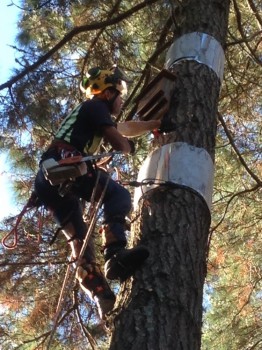Restoration is much more than just pulling weeds and planting native plants.
The Mangaiti Gully Restoration Trust tackles restoration in a very holistic way. Rex Bushell, coordinator of the Trust is keen on encouraging the return of native creatures. “The reason we want native bush back in Hamilton gullies is so that it supports native and endemic fauna species,” he said.
The Trust has a number of programmes in place to support this objective. “Eradicating resident rats and possums and controlling reinvasion has resulted in a very successful tūī breeding season last year. You know you are on the right track when people who live on the gully say that they see and hear more native birds in the gully than they do when they visit the bush elsewhere in New Zealand,” Rex said.
The Trust has a long term planting programme to encourage kererū, (native wood pigeons) back into the city. There are the endemic long finned eel which are classified as nationally at-risk/declining and there are giant and banded kōkopu in the stream.
Stream planting programmes and management to support these species and an understanding of their requirements are an import part of any native forest restoration.
Rex said that the most exciting recent news is the identification in the gully of the New Zealand long-tailed bat or pekapeka. For some years now there has been a city wide bat survey and until last year it recorded them only in the south of the city.
However in 2018 one fly-past was recorded in the Mangaiti gully and this year two were recorded. With these encouraging signs the Trust has set up a programme to install twelve bat homes (roosting boxes) in 1.6 km of the gully running from Thomas Road to Wairere Drive.

Photo by Sabine Pahl
The long-tailed bat can be found throughout New Zealand in varying habitats, but numbers are declining because of the removal of trees, predation by pests such as rats and stoats and competition for a diminishing number of roosting sites with other animals and birds.
Hamilton is one of the few cities in New Zealand that supports a resident bat population.
Because they fly at night few people are aware of them. Long-tail bats are capable of long distance flight and are nomadic. They do not stay in one roost site like many overseas bat colonies but move among a number of roosts. During breeding season the colonies may split up with males and females occupying different roosts.
“These are really interesting little fellows” said Rex. “Their body size is only slightly bigger than a mouse, so they are very small compared to other bats.”
This restoration work is happening right here in Hamilton’s Huntington suburb.
If you feel you would like to be involved in this type of project the Trust runs working bees every Wednesday morning. For more information contact Rex Bushell on phone 854-0973 / 021-237-3857 or email gullyrestoration@gmail.com.
You might also like to check out their website.

